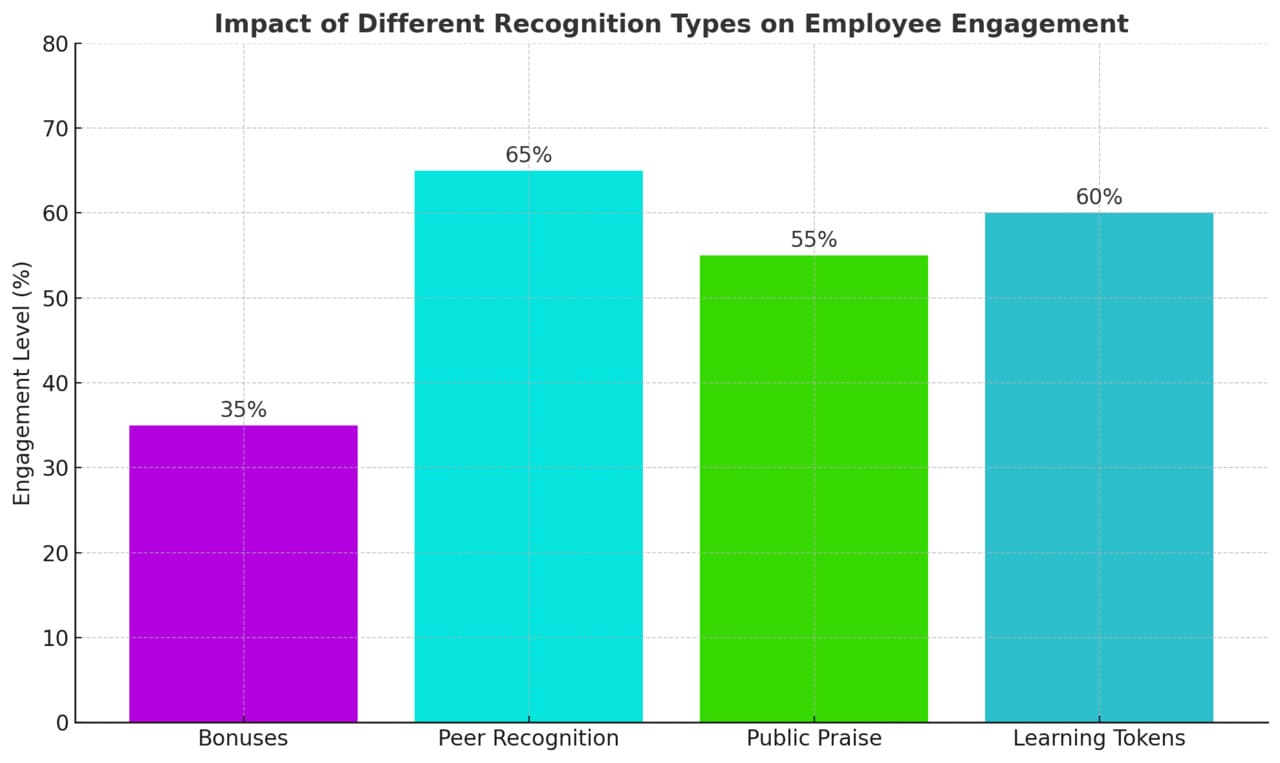The Rise of Internal Corporate Currency: How Recognition Drives Performance — Without Raising Salaries
Beyond bonuses: how trust-based, peer-driven recognition systems are reshaping motivation, retention, and culture in distributed organizations.
- What Is Internal Corporate Currency?
- Recognition vs. Rewards: Why Money Alone Doesn’t Motivate
- Cultural Impact: Making the Invisible Visible
- Pitfalls to Avoid
- Platforms Like AlbiCoins: Designing for Trust, Not Just Points
- Conclusion
Bonuses don’t build culture. Recognition does.
And in today’s hybrid, fast-moving organizations, the real drivers of performance aren’t found in spreadsheets or salary bands — they’re embedded in daily interactions, invisible contributions, and the psychological safety to show up and do the hard work that often goes unnoticed.
1. What Is Internal Corporate Currency?
Internal corporate currency refers to a system of non-monetary value — often tracked through tokens, points, or acknowledgments — that employees earn through actions aligned with company culture: peer support, cross-team collaboration, mentoring, learning, and problem-solving.
Think of it as a live feedback loop: recognition becomes tangible, shareable, and transparent.
Examples:
- A product engineer gives tokens to a teammate who helps unblock a sprint.
- A customer support rep is awarded points for mentoring new hires.
- A cross-functional task force earns internal “credits” for launching a new workflow — later redeemable for experiences, visibility, or privileges.
Companies like Atlassian, Cisco, and Finnish fintechs have experimented with peer-issued points, recognition badges, and internal marketplaces — not as gimmicks, but as a way to codify what the company actually values.
2. Recognition vs. Rewards: Why Money Alone Doesn’t Motivate
While bonuses and spot rewards are familiar tools, they tend to operate top-down and focus on short-term performance. Recognition systems, when designed well, build long-term engagement by reinforcing behaviors aligned with purpose and culture.
Intrinsic vs. Extrinsic Motivation
Behavioral research (Daniel Pink’s Drive) highlights three key motivators: autonomy, mastery, and purpose. Monetary rewards rarely tap into these — in fact, they can crowd out internal motivation.
McKinsey’s insight: non-financial recognition is often a more powerful retention lever than pay increases.
Harvard Business Review echoes this: “Recognition from peers is more meaningful than from managers — because it signals trust, respect, and inclusion.”

3. Cultural Impact: Making the Invisible Visible
Internal currencies do more than “reward.” They signal what matters. They surface effort that’s otherwise hidden: emotional labor, cross-functional help, unglamorous fixes, and behind-the-scenes support.
Why it works:
- Visibility: Employees see where they stand, what’s appreciated, and who contributes.
- Reinforcement: Behaviors aligned with values are spotlighted and repeated.
- Distributed trust: Recognition doesn’t flow from hierarchy but from peer insight.
This democratization of value signals can help bridge the gap between “official” KPIs and real impact, especially in flat or async teams where managers don’t see everything.
4. Pitfalls to Avoid
Recognition systems are not plug-and-play. Poor design can backfire:
| Pitfall | Impact |
|---|---|
| Over-gamification | Fatigue, manipulation, reduced meaning |
| Misalignment with values | Rewards the loudest, not the most aligned |
| One-size-fits-all models | Fails across cultures or functions |
| No reflection or feedback | Points feel transactional, not relational |
Successful systems require curation, feedback loops, and cultural calibration. They must reflect the organization’s identity — not someone else’s playbook.
5. Platforms Like AlbiCoins: Designing for Trust, Not Just Points
Modern solutions like AlbiCoins allow HR and People leaders to build measurable, adaptable recognition systems — without defaulting to gamification gimmicks.
AlbiCoins doesn’t offer “fun” leaderboards or competition. It provides:
- Transparent tracking of peer-issued recognition
- Flexible configurations for departments or regions
- Insights into engagement trends, invisible work, and value flow
More than a tool, it embeds recognition into everyday workflows — reinforcing trust, contribution, and culture where it actually happens.
Conclusion:
If value is only visible to management, are you really building a culture of performance?
Internal corporate currency systems challenge the old assumption that only leadership can define worth. In an era where engagement is fragile and top talent often operates beyond traditional job descriptions, companies must evolve recognition into something more organic, peer-driven, and aligned with culture.
The question for HR leaders isn’t if to invest in recognition. It’s how to do it in a way that’s sustainable, authentic, and strategic.
References:
- Daniel H. Pink – Drive: The Surprising Truth About What Motivates Us
- McKinsey & Company – The Boss Factor: Making the world a better place through workplace relationships
- Deloitte Human Capital Trends – 2020 Report: The Social Enterprise at Work


